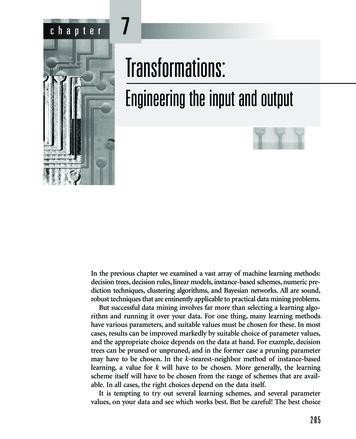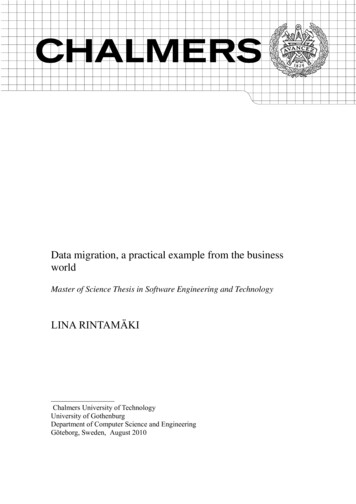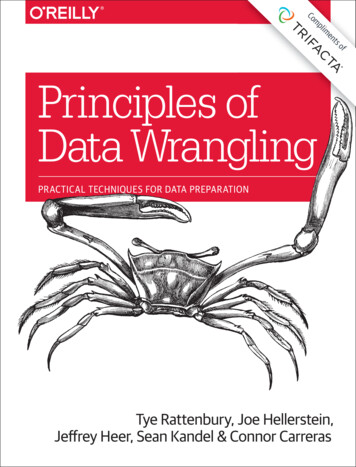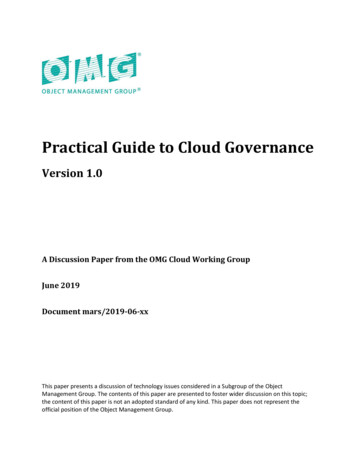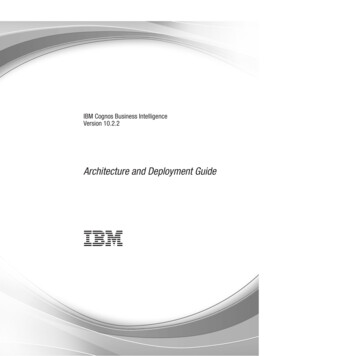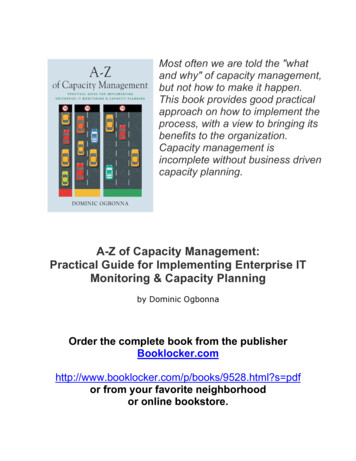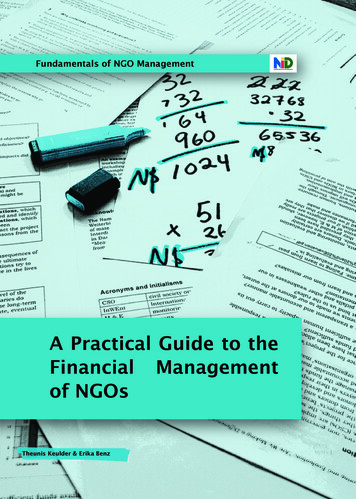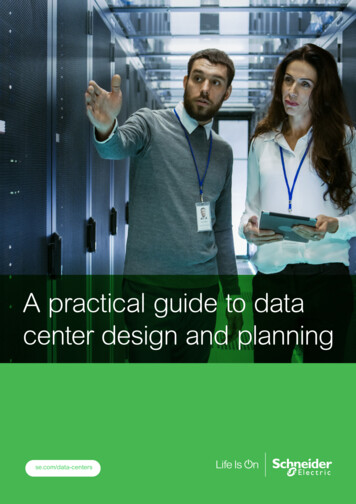
Transcription
A practical guide to datacenter design and planningse.com/data-centers
ContentsLife Is On Schneider Electric1
IntroductionLife Is On Schneider Electric2
In today’s world of being “on” 24/7, data centers are at the core of business and viewed asthe way to create competitive differentiation. Speed, efficiency, flexibility, and scale are nowcritical for winning the race to meet new connectivity and processing demands caused by theInternet of Things (IoT) and Big Data.Data centers enable the right insight to make better business decisions. They have come along way from simply keeping the lights on.But while the value and role of data centers has changed, the way most people design themhas not. Historically each build started from scratch and, while it’s true that each data centerproject has unique needs, they also have a lot in common and there is much to be gained bytaking advantage of these commonalities.Still, planning data center projects remains a major challenge. Plans are often poorlycommunicated among stakeholders, and minor changes can result in major costconsequences further down the road. Planning mistakes often propagate through laterdeployment phases, resulting in delays, cost overruns, wasted time and, potentially, acompromised system.Not to worry — Schneider Electric has put together practical steps that include clearmethodologies, at-a-glance calculators and tools, and a comprehensive library of referencedesigns to simplify and shorten your planning process while improving the quality of the plan.As data centers continue to expand and evolve, a flexible design approach will help growbusiness quickly without excessive capital outlay or overbuilding. Data center referencedesign tools will help you avoid many of the common pitfalls and with adaptable, modularoptions it’s possible to future-proof your data center while meeting your current businessgoals (and budget).Life Is On Schneider Electric3
PlanLife Is On Schneider Electric4
PLANPlanning processAn obvious but often overlooked concept, data center planning and design must bedone in the right order from the outset. When the right decision makers are given the rightinformation in the right sequence the project will run more smoothly and possibly evenexceed expectations.Rather than presenting excruciating detail or an ambiguous outline without enoughinformation, proper planning turns overwhelming or vague requirements into completeblueprints. And it doesn’t have to be time consuming or frustrating. The SchneiderElectric project process for the data center life cycle includes a standardized plan phase,which consists of four tasks around the physical infrastructure, laying the foundation foreverything that follows.1. Establish key project parameters to control the systemarchitecture and budget.Start by identifying a business need. Then determine the project parameters aroundcriticality, capacity, growth, efficiency, density, and budget. These six key projectfactors set the high-level goals of the project.Overall goal of step 1: Ensure scarce executive time is applied to important decisions.Stakeholders: Finance, CEO, IT Executive, IT Operations Manager, Key Lines of Business Leaders2. Develop a system concept.The cornerstone of this task is the selection of a reference design. While there are asignificant number of possible reference designs, the six key project parameters willquickly rule most of them out. Once you’ve narrowed it down to a few, review them foradditional considerations such as logistics and vendor reputation.Overall goal of step 2: Choose a general concept of physical infrastructure.Stakeholders: IT Operations, IT Executive, Facilities Executives, Facility Engineer, ExperiencedConsultant3. Incorporate user preferences and constraints.These include technical design requirements that are not part of the six key projectparameters. But, rather than collect these upfront and use them to drive the overalldesign, it’s much more efficient to adapt user preferences and constraints after thedesign concept has been chosen. Otherwise, you’re more likely to steer away fromstandard designs, driving up cost and deployment time.Overall goal of step 3: Make concept adaptations to avoid reconsidering the system concepts.Stakeholders: IT Operations, Network Engineers, Facilities Engineers, Data Center Managers,Experienced ConsultantLife Is On Schneider Electric5
PLAN4. Determine implementation requirements.This involves collecting standards, codes, deadlines, resource assignments, andprocess requirements. Standard requirements include regulatory compliancestandards, subsystem compatibility, safety, and best practices. Project requirementsinclude deadlines, vendors that must be used, and special procurement or otheradministrative processes. Separating requirements into these two buckets will simplifythe job of creating a detailed system design.Overall goal of step 4: Create a set of rules to be followed above and beyond the outputs of theprevious three tasks.Stakeholders: Engineers, ArchitectsLife Is On Schneider Electric6
PLANReference designsAs outlined earlier, the approach to data center design hasn’t changed much over theyears. Historically, each build was considered custom and started from scratch. However,although each data center has exclusive needs, there are also a lot of commonalties.With the call for faster planning and building and the reality of tighter budgets, fewer staff,uncertain IT loads, and a need for high availability, it’s no longer practical or cost effectiveto engineer all aspects of a data center uniquely. There is much to gain from the reuse ofproven, documented subsystems or designs.Data center projects: Advantages of using a reference designReference designs are often used in home construction. Regardless of the level ofcustomization, using a reference design can be beneficial, albeit to varying degrees.Standard home planReference design only Very fast Very repeatable Very predictable performance,cost, scheduleSemi-custom home planReference design with custom finishing elements Fast Repeatable — but withcustom finishes Predictable performance,cost, scheduleAll three plansbenefit from using areference design.Custom home planBase design by domain, heavily adapted Faster than starting from scratch Repeatable domains —kitchens, rooms, garage Less predictable performance,cost, and scheduleLife Is On Schneider Electric7
PLANThis is why Schneider Electric has mapped out a simplified way to plan, design, build,operate, and assess with data center reference designs. A reference design is a systemblueprint with a list of attributes, such as system-level performance specifications, alongwith materials and components. This design could be for a complete data center or for asubsection of the data center, such as an IT pod, IT room, power plant, or cooling plant.After decades of thought leadership in building data centers, our reference designs arebased on best practices — what has and hasn’t worked in the thousands of data centerswe’ve built over the years. Our catalog of designs enables you to quickly find those thatbest fit your requirements with minimal adaptations, helping you plan faster, reducepossible risks, and reliably predict future performance. You can mix and match elements— such as cooling, power, and redundancy — and see how these changes might impactyour design.GO TO REFERENCE DESIGNSAdopting a well-conceived reference design can have a positive impact on both theproject itself and on the operation of the data center over its lifetime. These high-levelconceptual plans simplify planning by helping project teams quickly determine key projectparameters, providing a head-start into the detailed design phase.“These things aren’t marketing tools with pretty pictures,” says Patrick Donovan, seniorresearch analyst for the Schneider Electric Data Center Science Center, in CustomerFeedback on Our Data Center Reference Designs.Life Is On Schneider Electric8
PLANSchneider Electric design documentation includes a high-level design summary and anengineering package with CAD drawings, piping diagrams, dimensioned floor layouts, aDCIM use-case, and an equipment list. And it’s not just for engineers, either; it’s designedfor the layperson to understand.Most importantly, these designs are malleable. Whether you’re planning a new build,retrofit, or expansion, the flexibility of the power skids and IT pods allows for a range ofconfigurations to be tailored to meet future needs. It’s akin to playing with Lego bricks.“For decades, Lego has remained ahead of the market by producing millions of plasticblocks that all fit together,” says Joe Reele, vice president of data center solution architectsat Schneider Electric, in a blog post.“When you buy a box of Lego, there may be instructions on how to build a race car, butreally there’s nothing stopping you from building any other sort of car,” says Reele.“Reference design #21, for instance, is customizable in the same way —the different inputs you put into the model will create different outputs,”Reele explains.This particular design is ultra flexible and utilizes modularbuilding blocks, easily scalable from 200 kW to 3.6 MWof capacity (or more), which can be implemented in apiecemeal fashion.“Ultimately, the data center is a purpose-built facilitycomposed of prefabricated power and cooling modules joinedwith an IT space,” says Reele. Given the flexible architecturebehind the design, the data center can be easily reconfiguredto support a range of densities, build methods, tier levels, coolingarchitectures, and capacity ranges.You can freely browse the Schneider Electric library of reference designs to select,compare, and choose the best design for your organization — whether you’re involved inco-location, cloud/hosting, multitenant, or enterprise-level data centers.Life Is On Schneider Electric9
PLANData center planning resourcesWhite PapersWhite Paper 147: Data center projects: Advantages of using a reference designWhite Paper 81: Site selection for mission-critical facilitiesBlogsA new way to think about data center design: Optimizing your data center like abox of LegosCustomer feedback on data center reference designsWebinarEcoStruxure for Data Centers: A Game ChangerResourceReference Design LibraryLife Is On Schneider Electric10
PLANCost analysisJust as the needs of a data center vary, so do budgets, which can be the biggestobstacles when building or upgrading data centers. Using deep scientific research anddata trending for a wider benchmark, we created several tools to make sure your datacenter requirements align with your project budget early in the planning stages.These tools provide a general idea of costs (as opposed to a formal quote) and can setoverall expectations around cost based on various options. Our cost calculators generatereal, but estimated numbers so you can make appropriate decisions regarding capacity,criticality, and density. When all stakeholders understand the possible costs, you canavoid the time and additional expense of cycling through unnecessary changes.The Data Center Capital Cost Calculator walks you through different scenarios of key datacenter design physical infrastructure parameters and calculates estimated costs based onthe various parameter inputs.Data Center Capital Cost CalculatorOPEN CALCULATORLife Is On Schneider Electric11
PLANBy identifying load, redundancy, density, and key power and cooling requirements, the toolcan project the number of racks, the floor space, and overall capital cost requirements.Higher redundancy, for example, is often a top priority, but budget has a direct impact onhow much redundancy is feasible.The primary value of this tool is to evaluate how architectures will perform relative toeach other for a defined location and configuration. Schneider Electric offers efficiencyassessments to obtain actual efficiency values for a specific data center.Design cost analysis resourcesBlogA tool to help align your data center business requirements with your project budgetTradeoff toolData center capital costLife Is On Schneider Electric12
DesignLife Is On Schneider Electric13
DESIGNProcessAt a high level, the following diagram illustrates what typically occurs during the designphase and the eventual transition to the build phase for a new data center project. Thisprocess is outlined in detail within White Paper 195: Fundamentals of managing the datacenter life cycle for owners.In this phase, the detailed design work takes place, resulting in site-specific schematicsand buildable construction documents (drawings and specifications). It is all too commonto go through multiple design iterations as requirements, preferences,and constraints change or surprises occur, which is why the early planning phase isso important. Managed properly ahead of time using the tools we have presented, thesecostly, time-consuming iterations will be minimized.Design phase transitioning to build phaseOwner’s design requirements from plan phaseOwner evaluates,hires, and enters intocontract with.Architect & CE firmORDesign/build firmKey Tasks:Project management, meet budget, feasibility studies, preliminary design,detailed design & specification, quotation, hire/bid general contractor and/or sub-contractors for build & commissioning phasesDetailed design outputs (approved by owner):Likely parties involved indetailed design:Owner/owner’s repArchitectMEP engineersStructural, civil engineersIT consultantsEnergy/LED consultantsCommissioning agentFacility operators Schematic design(10% complete) Design development(50% complete) Constructiondocuments (100%complete)General contractorCycles of design iterationtypically take place asrequirements, preferences,and constraints change.If construction delivery modelis “design/bid/build”, biddingby contractors often takesplace at each of the designdocumentation levels (10%,50%, 100% are common).hired by architect or design/build firmElectrical contractorNetworking contractorMechanical contractorLow voltage contractorLife Is On Schneider Electric14
DESIGNUsing a “design/bid/build” construction delivery model, construction general contractorsand subcontractors are chosen through a process of bidding at each of the designdocumentation completion levels.Within a data center project, stakeholders often refer to “design and constructionteams.” The design group is typically composed of the architect, mechanical-electricalpower (MEP) engineering, and IT. The construction team primarily includes the generalcontractor, subcontractors, and equipment vendors.The project owner or his or her representative typically hires an architect who, in turn, hiresa consulting engineering (CE) firm (if one is not already on staff or call) to begin to translatethe high-level owner’s requirements into detailed design documents.Alternatively, there are all-in-one “design/build” firms that specialize in data center projectsand may also offer commissioning, facility operations, energy management, and evenconstruction management services. The White Paper outlines a number of questions toask when selecting a firm or contractor.Since getting the right people involved, at the right time, and focused on the right things isso important for success, the contract should define and document key stakeholders’ rolesand responsibilities by phase, define compensation and insurance requirements, describethe cost of work, dispute resolution methods, change order process and limitations, andtermination grounds and processes. The scope of the contract should span both thedesign and construction phases. All teams must work hand-in-hand at all stages to ensurewhat’s been designed and planned comes to fruition.Life Is On Schneider Electric15
DESIGNSite selectionIt’s time to find a location for your data center. Organizations often start searching for theperfect space to build before having design criteria and performance characteristics inplace. But, without this vital information it doesn’t make sense to spend time visiting orreviewing potential sites.When selecting a new site or evaluating an existing site, there are many risks and benefitsthat must be considered in order to optimize availability and keep control of cost.Dry flood proofingAccording to Wendy Torrell, strategic research analyst, Schneider Electric, “Geographicand regional, local and site-related, and building risks need to be understood and mitigatedto lessen the downtime effects on your business. Meanwhile, site selection can offerfinancial benefits when a data center considers climate, electricity rates, and incentives.”Life Is On Schneider Electric16
DESIGNWendy details three major categories of risks in her White Paper 81:1. Geographical risks are major availability threats including natural disasters, as well asman-made hazards.2. Local risks are those that result from the municipal infrastructure, the local environment,local regulations, and employees.3. Building risks are driven by building characteristics and constraints, such as age of thebuilding, types of loads running, and the type and quality of the facility.When a thorough site selection review process becomes part of a data center project, thebusiness can expect both downtime risk-reduction and cost savings.Flood-resistant materialsLife Is On Schneider Electric17
Best practices and success storiesAs you plan, design, and choose your technology, there’s nothing like seeing realworld results of data center builds to help fully understand the value of all the availableresources from Schneider Electric.Life Is On Schneider Electric18
BEST PR ACTICES AND SUCCESS STORIESMainfreightNew ZealandNo one can accuse Mainfreight of thinking small. You have to think big to take a localtrucking company in New Zealand and grow it to a global logistics giant — one withwarehouses around the world.That bold thinking about growth means they don’t just think five or 10 years down the road.“The 100-year vision is something that our company founder came up with,” said DavidHall, Group IT Infrastructure Manager of Mainfreight. “If we invest 50 million dollars in anew facility, we’re not doing that thinking about it over the next 20 years — we’re thinkingabout that over the next 50 years or so.”Mainfreight at a glance: Global logistics provider International end-to-end freight service 239 branches across 21 countries 7,000 team members 51.1 million dollar IT investmentTo understand why Mainfreight plans their growth with such a longterm strategy, it’simportant to understand the mentality that drives this ambitious company, from the bottomof the world, to reach the top of their industry.SHARE THISREAD MORELife Is On Schneider Electric19
BEST PR ACTICES AND SUCCESS STORIESAnimal LogicAustraliaWith over 25 years experience, independent Australian company Animal Logic has been atthe forefront of creating digital content, award winning visual effects and animation for the filmand television industries.Animal Logic prides itself on dreaming big for the big screen and as a result their data centersolution needed to be equally as ambitious. They chose a Schneider Electric EcoStruxuremodular data center because it was prefabricated, fully customizable and has a reputation forflexible engineering, and promises fast deployment.Understanding Animal Logic’s unique needs for capacity and delivery, Schneider deployeda custom modular data center in just under four and a half months. The new infrastructuredelivered a major boost in data processing, which in turn enabled greater performance andoperational agility.SHARE THISREAD MORELife Is On Schneider Electric20
BEST PR ACTICES AND SUCCESS STORIESDigiPlexNorwayDigiPlex is a leading data center operator in the Nordics, dedicated to responsible,sustainable growth.Innovative products that push efficiency benchmarks were needed in order to achieveambitious goals in a power-intensive industry. Checking your account balance on yourapp. Watching the latest viral video. Uploading a selfie to social media. We take theseactions for granted, but there’s a lot going on behind the scenes.Very little of what we do on our devices actually happens in them; data centers are thenerve centers of our connected world.In a society that grows more connected every day, data centers are sources of enormouspower consumption. This presents a formidable challenge for colocation providers likeDigiPlex in Norway, which seeks to grow in a competitive business environment whilebeing a responsible corporate citizen.SHARE THISREAD MORELife Is On Schneider Electric21
ConclusionToday’s business needs can’t wait for traditional disjointed data center planningprocesses, lengthy design phases, and long deployment times. So, tap into theSchneider Electric experience and take advantage of the services of our experts.Use our proven methodologies and scientifically created standards for assessingyour needs and costs. Make the most of our existing blueprints and take advantageof the latest technologies. Leveraging these tried and true successes will enableyou to avoid failure now and ensure your data center is ready for what’s next.Life Is On Schneider Electric22
se.com/data-centers 2020 Schneider Electric. All Rights Reserved. Schneider Electric Life Is On are trademarks and the property of Schneider Electric SE, itssubsidiaries, and affiliated companies. All other trademarks are the property of their respective owners. LinkedIn, the LinkedIn logo, the IN logo,and InMail are registered trademarks or trademarks of LinkedIn Corporation and its affiliates in the United States and/or other countries.998-20798852 GMA-USLife Is On Schneider Electric23
As outlined earlier, the approach to data center design hasn’t changed much over the years. Historically, each build was considered custom and started from scratch. However, although each data center h
